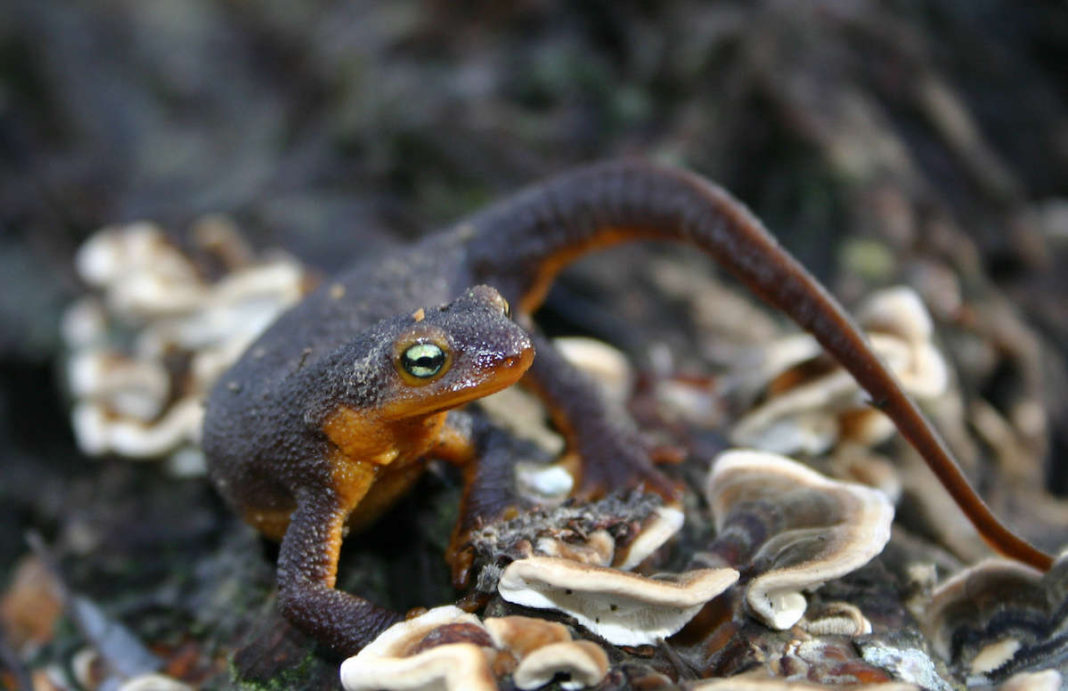In the Bay Area, our winter is a subtle one: Daytime temperatures sidle down into the 50s, there’s a hint of a nip in the air and everyone puts their scarves on. And, it rains—not a lot, but just enough to lure the East Bay’s newts out of their damp burrows and send them crawling across wood and road in search of a mating pool.
The East Bay has two endemic newt species: taricha torosa, the California newt, and taricha granulosa, the rough-skinned newt. They look almost identical, and both species spend the winter searching for a mate. “They have to do their breeding cycle in water,” says Natalie Reeder, a wildlife biologist with East Bay Parks. “They’ll go to ponds, slow-moving streams or pools within streams, depending on what’s available.”
But first, they have to get there: a strenuous, hazardous migration for a five- to eight-inch animal. Tilden Regional Park closes South Park Drive to traffic every winter between November and March to protect the newts that slowly slither across, vulnerable to cars.
Newts are intriguing, enigmatic creatures, full of impressive transformational abilities. They begin their life in water, hatching into larvae with feathery gills that wave out from their heads like eccentric facial hair, or a Victorian ruff. Then, both California and rough-skinned newts develop lungs as they outgrow their larval stage and leave their natal pools for life on land.
“Newts are to salamanders as toads are to frogs,” Reeder explains. Like toads, they’re a little drier, and better at living away from water—but they still have to stay moist to survive. “Newt skin is capable of being drier than a more fully aquatic salamander. But they do need to have some moisture. Amphibians are not meant to be fully dry.”
Another impressive newt superpower is the potent neurotoxin, tetrodotoxin, that both California and rough-skinned newts secrete from their skin. The toxin weakens and paralyzes muscle tissue, including the diaphragm and chest wall muscles, stopping breathing. “Humans can certainly be sick from it, or even die if they ingest enough of it,” Reeder says.
If threatened by a predator, newts will arch their back, lifting their body to show off their neon orange bellies. The bright color warns the attacker about their toxicity. The phenomenon of aposematism—animals advertising their toxicity to potential predators through warning coloration—is common in amphibians.
Rough-skinned newts in particular are impressively toxic; few predators can survive eating them. One exception is the common garter snake, which has developed a resistance to newt toxin. It’s a famous example of coevolution, often described as an evolutionary arms race. Poisonous newts push garter snake populations to evolve to be resistant to their toxin, Reeder explains. Then, “newts get more toxic in response, then garter snakes get more resistant in response. And that’s what drives the newts to get more and more poisonous.”
One side effect of extreme toxicity is a certain boldness. “Because they’re toxic, they’re not super afraid. They don’t spend too much effort trying to hide themselves,” says Reeder.
Winter is the perfect time for newt-spotting. “The best way to do it with the least amount of impact is to go to ponds during the breeding season,” Reeder suggests. “They’re usually pretty easy to see if you can find a pond that’s got clear enough water.”
When males return to pools to breed, they transform into a more aquatic form: Their skin becomes smoother, and their tails flatten and become more fin-like. Male rough-skinned newts develop special, grabby “nuptial pads” on their toes to help them hang on to females.
Newt courtship involves a kind of mating dance where the male shows off his orange belly and swishes his tail. Then, he hugs the female from above in a clasp called “amplexus,” and rubs his chin on the top of her nose to stimulate egg production. Competition, however, can be fierce; an amplexed pair may be approached by other males, creating a “mating ball” where as many as a dozen males cluster around a female, all grappling with each other until one male emerges victorious.
Then, if all goes well, he attaches a spermatophore, a packet of spermatozoa, to the floor of the pool; the female retrieves it and uses it to fertilize her eggs. California newts lay eggs in big bunches; rough-skinned newts lay eggs one at a time, carefully attaching each one to bits of underwater vegetation.
Two to three weeks later, tiny baby newts will be swimming about, eating microinvertebrates in the water. “I always like to say that for amphibians, they’ll eat anything that moves that fits in their mouth,” says Reeder. As the newts grow larger, they graduate to eating insects, spiders, mites, worms, mollusks and even small amphibians and fish.
Most of what biologists know about newts is centered around the breeding season, when they’re easier to find and observe. “Historically they’ve been understudied,” says Reeder. Once they leave their pools, the lives of newts become more mysterious. “We don’t really know where they go,” says Reeder. “It’s much harder to find them and track them.” Biologists can put a GPS collar on a mountain lion or glue a transmitter to a turtle shell, but tracking a newt is harder.
Reeder says that advancements in collecting environmental DNA have helped scientists study newt populations in more depth. “Instead of collecting the animal itself and getting genetic material from it, they go to a body of water, or take soil samples, and detect newt DNA in the sample,” she says.
California newts are a “species of special concern” in the state—in Southern California, populations have declined due to habitat loss and the destruction of breeding ponds. Luckily, Northern Californian populations have remained more stable, and the remarkable newt congregations of the winter and spring provide a window for scientists—and amateur enthusiasts—to meet our unique amphibian neighbors in person.
In the East Bay, newts can be found in Tilden Regional Park, Briones Regional Park, Sibley Volcanic Regional Preserve, Las Trampas Wilderness Regional Preserve, Pleasanton Ridge Regional Park and Sunol Wilderness Regional Preserve.
Newts are often active during the day, but the biggest factor for newt activity is dampness. The wetter it is, the more likely newts are to be on the move. To be extra sure of success, naturalist Trent Pearce recommends a post-sunset search.
“The best advice I have for finding newts is this: Go out after dark,” he advises. “The increase in ambient moisture after the sun sets is enough to get them moving about.”
Going newting right after a classic East Bay winter rainshower will yield even better results. Pearce reminds drivers to keep an eye open for an ethereal procession of amorous amphibians crossing wet roads. “There are newts underfoot,” he notes.
Get the timing right, and diligent seekers are sure to encounter a newt enjoying our wetter winters. “Find a stream, pond or even a large puddle after dark and look carefully with a headlamp,” Pearce says. “You’ll find them.”













